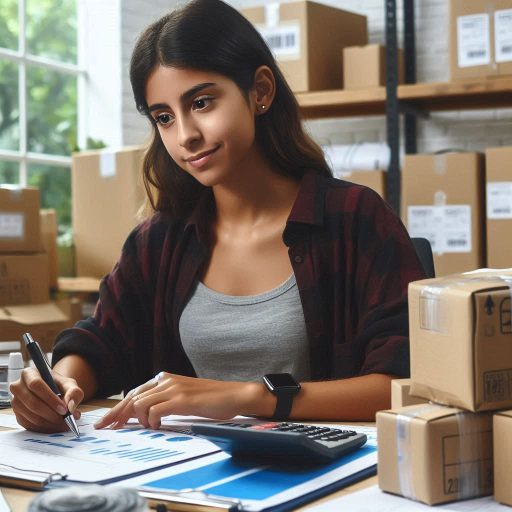Introduction
Packaging design is a powerful tool in modern marketing.
It influences how consumers perceive a product at first glance.
Effective packaging grabs attention, communicates brand values, and differentiates a product from competitors on crowded shelves.
It creates an emotional connection, making consumers more likely to purchase.
Packaging designers play a critical role in shaping this experience.
They are responsible for crafting packaging that is both visually attractive and functional.
Designers must consider color, typography, and imagery to convey the right message.
Beyond aesthetics, they ensure the packaging serves its purpose: protecting the product and providing convenience to users.
These designers also bridge the gap between brand identity and consumer expectations.
They translate brand values into tangible elements that speak to the target audience.
Their work goes beyond just making the packaging look good.
They also focus on sustainability, material choices, and functionality to meet modern consumer demands.
Good packaging design impacts purchasing decisions, brand loyalty, and even product safety.
Designers must balance creativity with practical needs, considering factors like cost, durability, and recyclability.
Their work directly affects how a product performs in the marketplace.
Concept Development Tools
Importance of Brainstorming and Sketching in the Initial Stages of Packaging Design
Brainstorming is a critical starting point for any packaging design project.
It allows designers to generate innovative ideas quickly.
During this phase, teams collaborate to identify the product’s unique selling points and target audience.
Brainstorming encourages creativity, helping designers think outside the box and develop multiple concepts.
These ideas can then be refined and tested against the product‘s branding needs.
The freedom to explore different directions during brainstorming fosters innovation and helps avoid a stale, predictable design.
After the brainstorming session, sketching transforms abstract ideas into tangible visuals.
Designers begin sketching out concepts on paper or digitally.
This step provides a visual framework for future iterations.
Sketching allows designers to experiment with layouts, shapes, and designs without heavy time investment.
It helps crystallize ideas, enabling quicker identification of concepts that work or fail.
Because it‘s a flexible and low-cost stage, sketching helps avoid costly design changes later.
By translating ideas into visual form early on, sketching ensures the design is both functional and creative from the outset.
Using Adobe Illustrator and Pantone Color Guides for Mock-ups and Color Schemes
Adobe Illustrator is an essential tool for packaging designers.
It offers precise control over shapes, lines, and typography.
Illustrator‘s vector-based capabilities make it ideal for creating scalable, sharp graphics for packaging.
Designers can fine-tune elements like logos, icons, and text, ensuring they remain clear at any size.
The software‘s vast library of tools allows designers to experiment with various layouts and shapes, helping them visualize how the final packaging will look.
Its interface is intuitive, allowing for both detailed work and rapid mock-up creation.
For color selection, Pantone color guides play an irreplaceable role in packaging design.
Pantone provides a standardized color matching system that ensures consistency across different materials and printing methods.
This is crucial in packaging design, where color accuracy can directly influence a brand‘s identity.
The use of Pantone‘s guides eliminates color inconsistencies between digital designs and the final printed product.
Designers can use these guides to select color schemes that evoke the desired emotional response from consumers.
Together, Adobe Illustrator and Pantone color guides allow designers to create realistic packaging mock-ups.
These tools help visualize how a package will appear in the real world.
Adobe Illustrator’s mock-ups combined with Pantone‘s precise color choices ensure a design’s visual integrity remains intact throughout production.
Creating detailed mock-ups also helps clients and teams visualize the end product, ensuring that expectations align.
Using these tools during the early stages of design streamlines the creative process, reducing revisions and costly errors.
Brainstorming and sketching lay a solid foundation for the packaging design process.
The integration of powerful design tools like Adobe Illustrator and Pantone color guides ensures the final product is visually compelling and production-ready.
Read: Best Tools and Software for Character Designers
3D Modeling Software
The Importance of 3D Modeling Software in Packaging Design
In the world of modern packaging design, 3D modeling software has become essential.
Tools like SolidWorks and SketchUp are transforming the way designers visualize their ideas.
These software programs allow designers to see their packaging concepts come to life in a three-dimensional space.
This capability adds value beyond traditional two-dimensional design approaches, making it easier to spot potential issues and improve overall design effectiveness.
By creating 3D models, designers can view packaging from all angles.
This full visualization helps ensure that the design works well in real-world conditions.
It also assists in identifying any flaws in the structure or appearance early in the design process.
With these tools, packaging designers gain an accurate sense of how their designs will look and function.
These tools give designers the ability to manipulate packaging designs in real-time.
They can rotate, scale, and tweak elements to perfect each detail.
This ability to make changes instantly reduces errors and saves time, leading to more precise designs.
SolidWorks and SketchUp offer features that make the design process smoother and more flexible.
How These Tools can Help Designers test out Different Packaging Dimensions and Structures
One of the biggest advantages of 3D modeling software is the ability to test different packaging dimensions and structures.
Before these tools, designers relied on sketches or physical prototypes to assess a design.
Now, designers can experiment with various design elements directly on the computer.
By doing so, they can identify the most efficient and cost-effective solutions for packaging.
For example, a designer can quickly alter the size of a box to fit different products.
They can also adjust the structure of the packaging to ensure it supports the weight of the item it holds.
This ability to play with dimensions helps streamline the design process.
Furthermore, it allows designers to anticipate potential issues before moving to the production phase.
With SolidWorks and SketchUp, designers can also perform simulations to test how packaging will behave in certain conditions.
For instance, they can assess whether a box will collapse under certain pressures or how it will look when placed on a store shelf.
This functionality gives designers valuable insights into the strength and durability of their packaging designs.
Improving Efficiency and Accuracy in Design
Using 3D modeling software significantly improves the efficiency of the packaging design process.
Designers can experiment with multiple ideas in a short time, saving effort and money.
By working digitally, they can skip some of the trial-and-error stages that would typically require physical prototypes.
Additionally, SolidWorks and SketchUp help reduce material waste by ensuring that the design is optimized before production begins.
As a result, packaging companies can minimize costs and make their processes more sustainable.
With 3D modeling tools, designers can confidently move from the digital space to the physical world with fewer surprises.
In fact, 3D modeling software like SolidWorks and SketchUp plays a pivotal role in modern packaging design.
By enabling visualization, testing, and refinement, these tools help designers create efficient, reliable, and visually appealing packaging.
Read: Ceramic Art: From Hobby to Professional Career
Prototyping Tools
The Importance of Physical Prototypes in Packaging Design
Creating physical prototypes is essential for evaluating packaging designs.
These prototypes allow designers to assess both the feasibility and functionality of their ideas.
While digital models are useful for visualization, they can‘t fully convey how a package will perform in the real world.
A tangible model gives designers and stakeholders a better sense of scale, materials, and structural integrity.
This hands-on experience can reveal potential issues that may not be visible in digital formats.
For example, a box that looks sturdy on screen might be fragile when produced.
A physical prototype helps identify such problems early in the process.
Designers can test the durability of materials and check if the packaging protects the product as intended.
Additionally, physical prototypes can demonstrate how the packaging will look on shelves, which is crucial for product marketing.
Consumers are more likely to be drawn to packaging that looks and feels high-quality.
Prototypes also ensure that packaging meets regulatory requirements, such as safety standards for shipping.
For instance, fragile products might require extra padding or more rigid materials.
A physical prototype allows you to test these elements under real-world conditions.
Adjustments can then be made before the final design is sent to mass production, saving time and money in the long run.
3D Printers: A Powerful Tool for Creating Physical Prototypes
3D printers have become indispensable tools in the packaging industry.
They allow designers to quickly create prototypes using different materials, from plastics to flexible substances.
3D printing speeds up the design process by allowing quick iterations of packaging concepts.
With this technology, a designer can adjust dimensions, structural features, and other design elements rapidly.
For example, if a particular aspect of a package‘such as a closure or handle‘is not functioning as expected, it can be reprinted with minor tweaks.
This flexibility allows for faster improvements without waiting for external suppliers or manufacturers.
As a result, 3D printing reduces the overall time to market.
Another key advantage of 3D printers is their ability to produce prototypes that closely mimic the final product.
With advanced materials, 3D printers can replicate the textures and stiffness of the actual packaging material.
This level of detail allows designers to assess how the package feels and behaves in different situations.
Prototyping Kits: A Versatile Solution for Tangible Mock-ups
Also, prototyping kits are valuable tools for modern packaging designers.
These kits come with a variety of materials like foam, plastic sheets, and adhesives, allowing designers to create mock-ups manually.
While not as high-tech as 3D printers, these kits are affordable and versatile.
Designers can experiment with different shapes, dimensions, and material combinations.
Prototyping kits are perfect for early-stage development when ideas are still being explored.
They enable designers to create quick, tangible representations of packaging concepts, offering a hands-on way to solve design challenges.
Read: How to Create Memorable Characters: Pro Tips

Sustainability Tools
The Growing Importance of Sustainability in Packaging Design
Sustainability has become a key concern for modern packaging designers.
As environmental awareness grows, companies are under increasing pressure to minimize their ecological footprint.
Packaging plays a significant role in this effort, as it’s often one of the first touchpoints between brands and consumers.
Reducing waste and utilizing eco-friendly materials are no longer optional; they’re essential.
Consumers today actively seek out brands that prioritize sustainability, driving the need for packaging that reflects these values.
The traditional ‘take-make-dispose‘ packaging approach is quickly becoming obsolete.
Packaging waste contributes significantly to pollution, particularly in oceans and landfills.
By adopting sustainable packaging practices, designers can help reduce this impact and create a more circular economy.
Sustainable packaging not only benefits the environment but also strengthens brand image and customer loyalty.
Regulatory standards are also pushing businesses to adopt more sustainable packaging solutions.
Governments around the world are implementing stricter regulations on packaging materials and waste management.
Packaging designers must stay ahead of these regulations by incorporating eco-friendly alternatives that meet both legal requirements and consumer expectations.
Tools for Eco-Friendly Packaging Solutions
Creating sustainable packaging solutions requires the right tools.
Life Cycle Assessment (LCA) software is essential for evaluating the environmental impact of packaging materials.
LCA software allows designers to assess the energy consumption, carbon footprint, and overall environmental impact of each stage of a product’s life cycle.
This analysis helps designers make informed decisions about materials and processes that reduce environmental harm.
LCA tools also provide measurable data that companies can use to communicate their sustainability efforts to consumers.
Several LCA tools are available to packaging designers, such as SimaPro, GaBi, and OpenLCA.
These tools evaluate different factors, including resource use, emissions, and waste generation, providing comprehensive insights into the sustainability of a packaging design.
By using these tools, designers can optimize packaging to be more efficient and less harmful to the environment.
Sustainable material databases are another crucial tool for packaging designers.
These databases provide extensive information on eco-friendly materials, helping designers select materials that minimize environmental impact.
Designers can explore materials like biodegradable plastics, recycled paper, and compostable films.
Databases such as Material ConneXion and Circular Economy Toolkits offer access to the latest sustainable materials available in the market.
Material selection is critical to sustainable packaging design.
Packaging made from renewable, biodegradable, or recycled materials significantly reduces the strain on natural resources.
Additionally, lightweight materials decrease transportation emissions, further reducing the environmental footprint of packaging.
Sustainability in packaging design is no longer a trend; it‘s a necessity.
Consumers, regulations, and environmental concerns are driving the shift toward eco-friendly packaging solutions.
Tools like Life Cycle Assessment software and sustainable material databases empower designers to create packaging that aligns with sustainability goals.
By embracing these tools and practices, packaging designers can make a lasting positive impact on both the planet and their brands.
Read: Ceramic Art Exhibitions to Visit in 2024
Find Out More: Top Companies Hiring Automotive Designers
Collaboration Tools
The Benefits of Collaboration Between Packaging Designers and Other Team Members
Collaboration between packaging designers and other team members enhances creativity and innovation.
Designers benefit from different perspectives, ensuring that their packaging aligns with marketing, branding, and customer expectations.
Teamwork also ensures that ideas are refined through feedback, reducing the risk of errors in production.
Marketing teams, for example, provide insights into target demographics, ensuring designs are appealing to the right audience.
Sales teams understand consumer needs and market demands, helping designers create packaging that stands out on shelves.
Additionally, involving engineers in the process guarantees that designs are practical for manufacturing and distribution.
This collaborative approach minimizes the risk of packaging being expensive to produce or difficult to assemble.
Collaboration with copywriters is also vital to ensure that packaging communicates the right message clearly and concisely.
Clear product descriptions, branding, and regulatory information must be communicated accurately, and packaging designers often rely on writers for this.
When teams collaborate, the entire packaging design process becomes more streamlined.
Deadlines are easier to meet, and the final product aligns with both the brand vision and practical considerations.
This cross-departmental cooperation also fosters accountability, ensuring that everyone is invested in the project‘s success.
Packaging designers benefit from having quick access to expertise from various departments, speeding up decision-making and reducing project delays.
Collaboration Tools Like Trello and Slack for Communication and Project Management
Effective collaboration is crucial for packaging designers working within a team.
Tools like Trello and Slack simplify communication and project management, making collaboration smoother.
Trello, a project management tool, allows teams to visually organize tasks and deadlines.
Designers can create boards, lists, and cards to track progress on different stages of the packaging design process.
It is easy to assign tasks, set deadlines, and track updates, which keeps everyone aligned and focused.
Slack, a communication platform, enhances real-time interaction between team members.
Designers can quickly share files, images, and updates with colleagues from various departments.
Slack‘s instant messaging feature allows for quick problem-solving without the formality of emails.
Teams can create channels for specific projects, ensuring that communication remains organized and accessible.
Both Trello and Slack integrate with other tools, making collaboration even more seamless.
For example, designers can link Trello boards to Slack channels, enabling the team to receive instant updates on project status.
This reduces confusion and helps keep everyone on the same page.
These tools allow teams to remain productive, regardless of location, which is especially important in today‘s remote working environments.
By utilizing collaboration tools like Trello and Slack, packaging designers can streamline communication, keep projects on track, and ensure that all team members are updated.
These tools foster efficient collaboration, reducing time wasted on miscommunication and allowing for faster decision-making.
In the fast-paced world of modern packaging design, effective use of collaboration tools is essential to delivering high-quality results on time.
Uncover the Details: How to Market Yourself as a Fashion Designer
Printing and Production Tools
Understanding Printing Techniques and Production Processes in Packaging Design
Understanding printing techniques and production processes is crucial in packaging design.
Designers who master these concepts create packaging that is both visually appealing and practical.
Different printing methods, such as offset, flexography, and digital printing, have unique limitations and possibilities.
Choosing the right technique ensures that the design’s colors, textures, and materials come to life as intended.
For example, offset printing offers high-quality results but is cost-effective only for larger print runs.
On the other hand, digital printing allows smaller, customized batches but can lack the precision of traditional methods.
Knowing these distinctions helps designers make informed decisions.
This knowledge can also affect the choice of materials, finishes, and the overall budget.
A designer who understands production processes will design with feasibility in mind.
Some ideas might look amazing on screen but are challenging to reproduce in print.
A good understanding of production techniques can prevent costly mistakes and rework.
Designers should also consider how packaging interacts with various printing processes.
This ensures the package looks as good on the shelf as it does in the design phase.
Transform Your Career Today
Unlock a personalized career strategy that drives real results. Get tailored advice and a roadmap designed just for you.
Start NowTools for File Preparation: Esko Studio and Adobe InDesign
Preparing files for print production requires specialized tools, and Esko Studio is one of the best.
Esko Studio offers 3D visualization, allowing designers to see how their packaging looks in real life.
This helps designers adjust their designs for better results.
It‘s particularly useful for packaging with complex structures, such as bottles or multi-part containers.
With Esko Studio, designers can spot potential problems before printing, saving time and money.
Adobe InDesign, on the other hand, is perfect for laying out packaging designs with precision.
It provides excellent tools for managing typography, images, and layouts.
InDesign‘s ability to handle complex page structures is beneficial for packaging designs that need attention to detail.
The software allows designers to create print-ready files with the right color profiles, fonts, and dimensions.
Both tools offer crucial functions that ensure the final product meets industry standards.
InDesign supports seamless collaboration with printers, thanks to its robust prepress features.
It ensures that files are properly aligned, with the correct bleed, crop marks, and resolution for printing.
This reduces the risk of errors during production.
Esko Studio and Adobe InDesign work hand-in-hand for packaging design.
Together, they help designers bridge the gap between creative concepts and print production realities.
With these tools, designers can experiment with their ideas and see how they translate into physical products.
This reduces back-and-forth adjustments with printers and speeds up the production process.
Understanding the printing techniques and production processes, combined with mastering tools like Esko Studio and Adobe InDesign, is essential for modern packaging designers.
These skills and tools ensure packaging designs are both innovative and feasible, delivering exceptional results.
Conclusion
Modern packaging designers need the right tools to create visually appealing and functional designs.
Utilizing appropriate tools can streamline the design process, ensuring efficiency and consistency.
Key software like Adobe Illustrator and Photoshop enable designers to craft high-quality graphics with precision.
CAD programs, such as AutoCAD, assist in developing structural designs that ensure the package’s functionality and durability.
3D modeling tools allow designers to visualize prototypes and spot potential issues before production.
These tools also help in creating realistic mockups, giving clients a better understanding of the final product.
Collaboration platforms like Slack and Figma enhance teamwork, allowing designers to communicate and share designs effortlessly.
Color management software ensures brand consistency across all materials, while prepress tools guarantee that designs are ready for printing without any errors.
Proper use of these tools reduces costly mistakes, saving both time and resources.
Ultimately, the right tools allow packaging designers to meet market demands efficiently and create standout designs.
A well-equipped designer can push creative boundaries, while ensuring functionality and manufacturability.
These tools are essential to delivering innovative, eye-catching, and effective packaging solutions in a competitive market.
Investing in and mastering them is crucial for a successful career in packaging design.
[E-Books for Sale]
The Big Book of 500 High-Paying Jobs in America: Unlock Your Earning Potential
$19.99 • 500 High-Paying Jobs • 330 pages
Explore 500 high-paying jobs in America and learn how to boost your career, earn more, and achieve success!
See All 500 High-Paying Jobs of this E-Book
1001 Professions Without a Degree: High-Paying American Jobs You Can Start Now
$19.99 • 1001 Professions Without a Degree • 174 pages
Discover 1001 high-paying jobs without a degree! Unlock career tips, skills, and success strategies for just $19.99!




